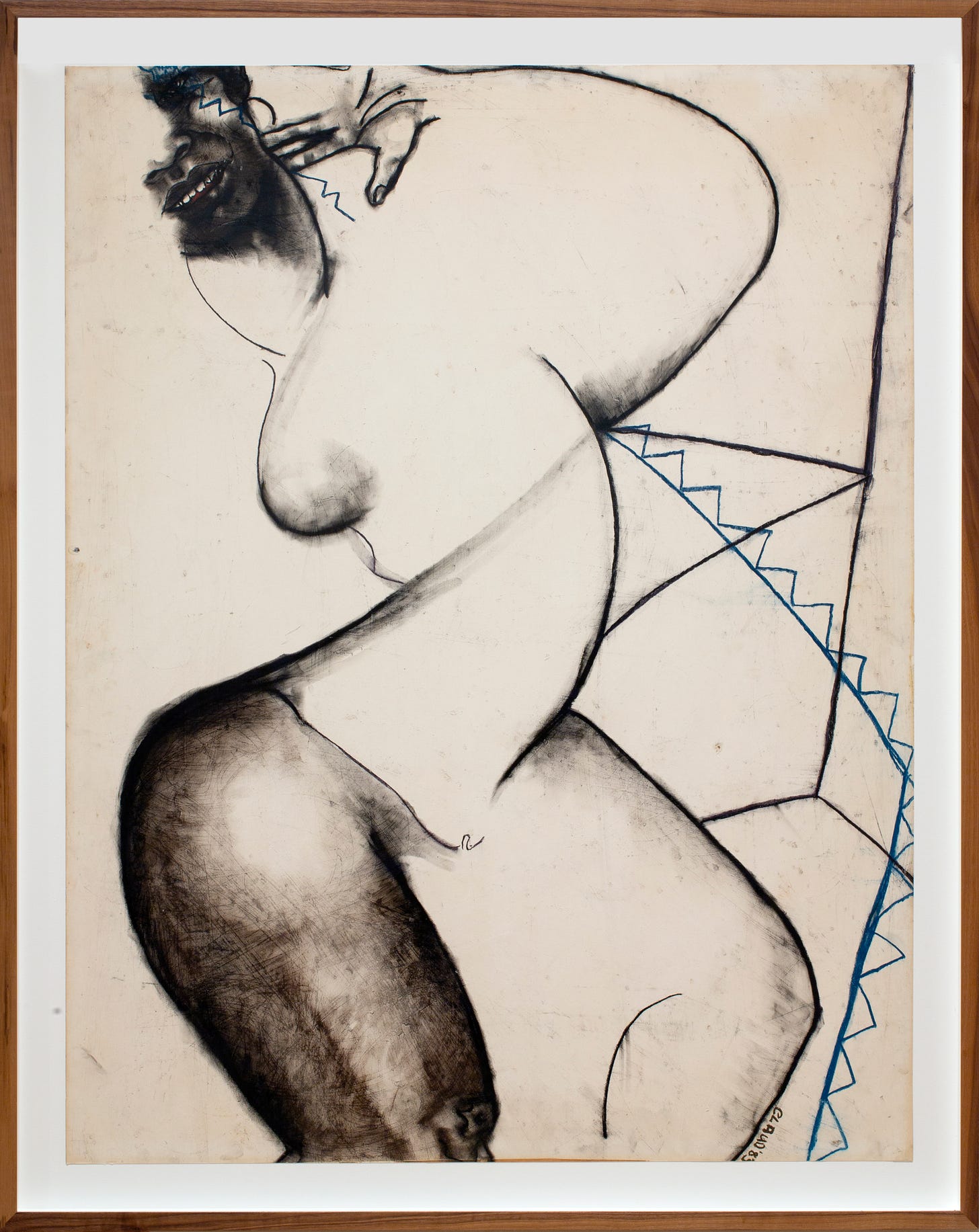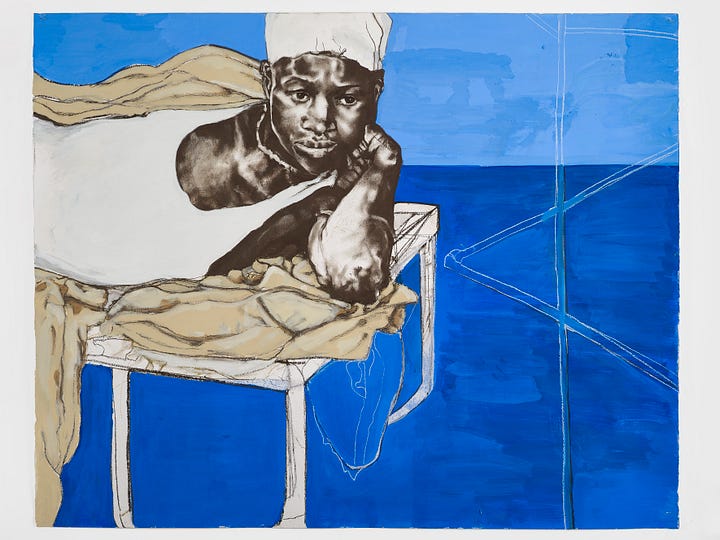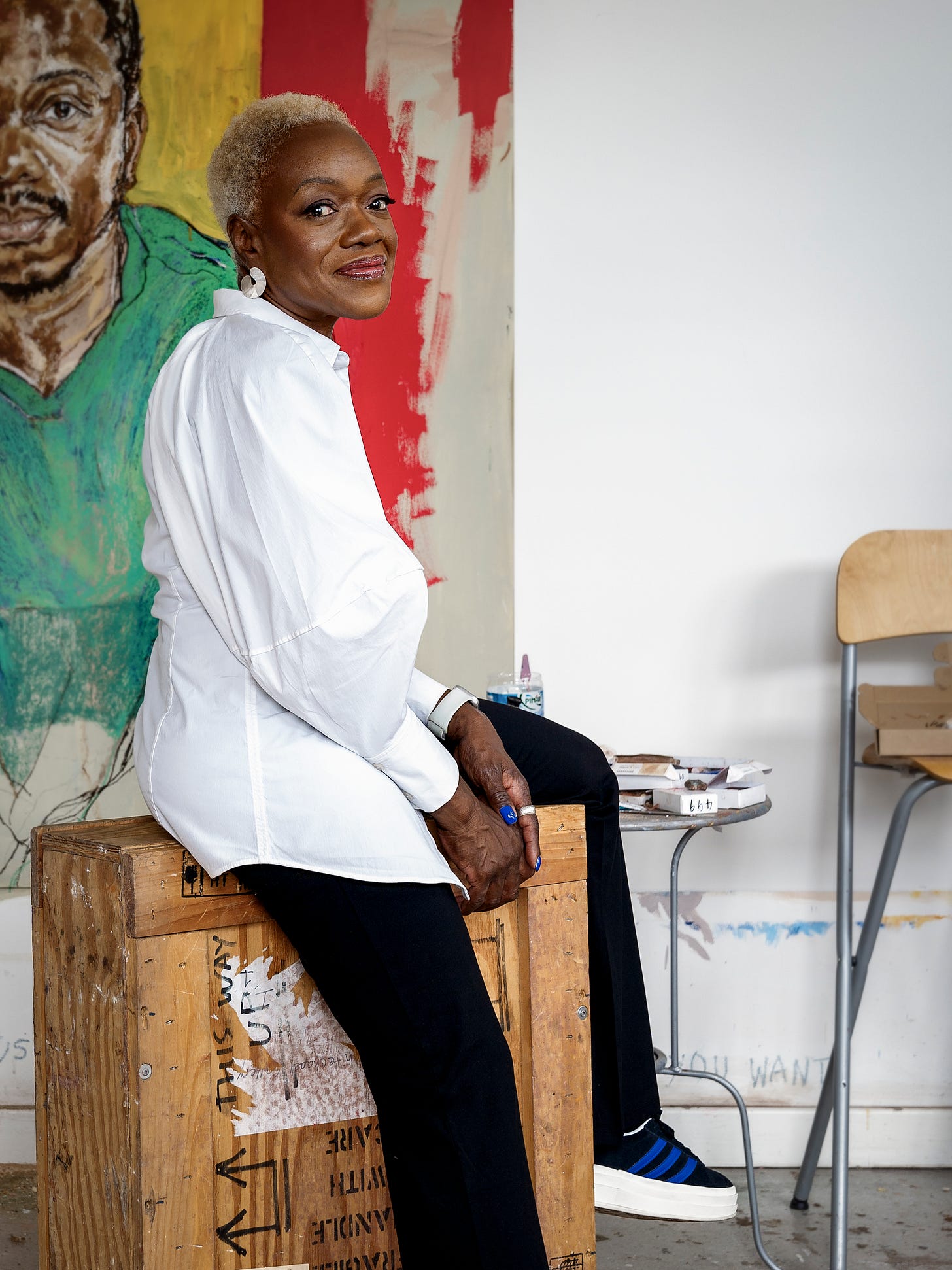How Music and Dance Influence Claudette Johnson
The renowned figurative artist on music and dance in her work.
Claudette Johnson creates large-scale works that challenge the erasure and misrepresentations of Black subjects, particularly Black women. Her drawings, a striking combination of contoured shading and bold line work, are intimate depictions of her subjects. These works, drawn from life, often feature family, friends, and herself. She views her sitters as collaborators who play a crucial role in her creative process. Johnson invites them to pose in ways that reflect who they are.
She was born in Manchester in 1959 and spent her formative years there before studying fine art at Wolverhampton Polytechnic in the 80s. As a student, Johnson co-founded the BLK Art Group, a collective of young Black artists who explored race, gender, and representation politics. Other notable members include Eddie Chambers, Keith Piper, Lubaina Himid and Marlene Smith. In 1982, the group organised the First National Black Art Convention at Wolverhampton Polytechnic. It was the first time in Britain that British art school graduates of African and Asian heritage gathered to examine aesthetics, politics and 'Black art.' Johnson's fifteen-minute presentation about her creative practice, Black female subjectivity and the portrayal of Black female figures in Western art was the only one by a female artist. She was heckled, interrupted and eventually shut down by men in the audience. A vote was taken and Johnson was asked to continue her discussion in a seminar room, separate from the main lecture theatre where the convention was held. Most of the women left the theatre to join Johnson. Her presentation was a watershed moment highlighting the dearth of Black women's perspectives in art and igniting the flames of the Black art feminist movement in the UK.

Despite her remarkable career, it's only in recent years that Johnson has begun to receive recognition from public institutions. Claudette Johnson: Presence at The Courtauld was her first monographic show at a major public gallery in London. I was lucky to see this stunning exhibition last October. It showcased both Johnson’s early works and her more recent ones. The vibrancy and intricacy of Johnson's mark-making were captivating.
Of the 17 works on display, “I Came To Dance” (1982) most attracted my attention. It is one of Johnson's earliest works, exploring dance in Afro-Caribbean cultures as both a "destructive stereotype" and a "source of pleasure and self-expression." Her use of lines, curves, and space to convey rhythm and movement entranced me.

In other drawings, Johnson works with photographs and found media images. “Blues Dance” (2023) pays homage to the Blue Beat reggae scene of the 1980s. This work, inspired by a photograph, portrays a woman elegantly swaying in a blue dress. Johnson's affinity for the colour blue and musical expression is also evident in "Kind of Blue" (2020). This drawing, named after the iconic 1959 Miles Davis album, references a photograph taken by South African photographer Peter Magubane.


After the exhibition, I realised that music and dance are integral to Johnson's practice. Although she has spoken about music and dance in various interviews, I had yet to encounter an in-depth discussion about this topic. I decided to interview Johnson to shed light on this aspect of her work.
In December, I spotted Johnson at a quaint café in East London. She was engrossed in conversation with Samallie Kiyingi, a passionate art collector championing the work of African and diasporan artists. Seeing the greats IRL always makes me ridiculously starstruck. I fall into a trance, and my bodily functions vanish. Memories of my encounter with Jose Mourinho, where I was speechless, came flooding. Worried that history might repeat itself with Johnson, I left the café. But logic entered the chat, and I remembered that despite her achievements, Johnson is human. I returned to the café and went over to their table. Johnson and Kiyingi were warm and approachable. I expressed my deep admiration for Johnson's art and her incredible exhibition. Looking back, I believe this interaction helped secure the interview with Johnson.
You can listen to my conversation with Johnson here.
References: Claudette Johnson: I Came To Dance, Edited by Emma Ridgway.
From the cutting room floor…
Johnson enjoys listening to Frank Ocean and Brittany Howard. She told me why she loves Ocean’s Pink + White and Howard’s music.
Siima’s Picks
This is a playlist with songs mentioned in the interview and others inspired by Johnson. (Apple Music peeps, I got you)
Watch the curator’s tour of the Claudette Johnson: Presence exhibition.
View the BLK Art Group archive. Be sure to check out the recording of Johnson’s powerful presentation, which starts around 04:51.
Read this beautiful meditation on the significance of the colour blue in the work of Black filmmakers, musicians, and photographers. Shadé’s newsletter is filled with thoughtful commentary on music album covers - I highly recommend subscribing!
Learn about the members of Miles Davis’ electric band.
Buy this exhibition catalogue from Johnson’s 2019 solo exhibition at Modern Art Oxford. In my podcast episode, I referenced this book's insightful Q&A between Johnson and curator Emma Ridgway. You’ll also find essays about Johnson’s work, including one by the artist herself.
Current and upcoming exhibitions
Claudette Johnson: Darker Than Blue, The Barber Institute of Fine Arts, Birmingham, UK (closes on 15th September 2024).
Drawing Time: Duets, Sharjah Art Foundation, UAE (closes on 4th August 2024).
Turner Prize Exhibition, Tate Britain, London (25th Sept 2024 - 16th Feb 2025).
Earlier this year, Johnson was nominated for a Turner Prize, one of the world’s most prestigious art awards. This exhibition includes work by Johnson and other finalists.
Love,
Siima





💙💙💙💙💙💙💙💙 love it! I also thank you for sharing her story!
Thank you! 💙💙💙